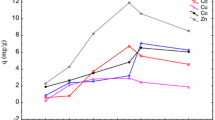Abstract
We prepared capsules containingSaccharomyces cerevisiae andZoogloea ramigera cells for the removal of lead (II) and cadmium ions. Microbial cells were encapsulated and cultured in the growth medium. TheS. cerevisiae cells grown in the capsule did not leak through the capsule membrane. The dried cell density reached to 250 g/l on the basis of the inner volume of the 2.0 mm diameter capsule after 36 hour cultivation. The dry whole cell exopolymer density of encapsulatedZ. ramigera reached to 200 g/L. The capsule was crosslinked with triethylene tetramine and glutaric dialdehyde solutions. The cadmium uptake of encapsulated whole cell exopolymer ofZ. ramigera was 55 mg Cd/g biosorbent. The adsorption line followed well Langmuir isotherm. The lead uptake of the encapsulatedS. cerevisiae was about 30 mg Pb/g biomass. The optimum pH of the lead uptake using encapsulatedS. cerevisiae was found to be 6. Freundlich model showed a little better fit to the adsorption data than Langmuir model. 95 percent of the lead adsorbed on the encapsulated biosorbents was desorbed by the 1 M HCl solution. The capsule was reused 50 batches without loosing the metal uptake capacity. And the mechanical strength of the crosslinked capsule was retained after 50 trials.
Similar content being viewed by others
References
Volesky, B. and N. Kuyucak (1988) Biosorbent for gold.U.S. Patent, 4,769,233.
Buchholz, K. (1979) Characterization of immobilized biocatalysts. In: DEchema monograhs, vol. 84. Verlag Chemie, Weinheim.
Wada, M. J., J. Kata and I. Chibata (1980) Continuous production of ethanol using immobilized growing yeast cells Eur.J. Appl. Microbiol. Biotechnol. 10: 275–287.
Gosmann, B. and H. J. Rehm (1986) Oxygen uptake of microorganisms entrapped in Ca-alginate Appl.Microbiol. Biotechnol. 23: 163–167.
Cheong, S. H., J. K. Park, B. S. Kim and H. N. Chang (1993) Microencapsulation of yeast cells in the calcium alginate membrane.Biotechnol. Techniq. 7: 879–884.
Cheong, S. H., T. J. Lee, J. K. Park and H. N. Chang (1995) L-lysine production using encapsulated Corynebacterium glutamicum.J. KIChE 33: 105–112.
Chang, H. N., G. H. Seong, I. K. Yoo, J. K. Park and J. H. Seo (1996) Microencapsulation of recombinantSaccharomyces cerevisiae cells with invertase activity in liquid-core alginate capsules,Biotechnol. Bioeng. 51: 157–162.
Nigam, S. C., I. F. Tsao, A. Sakoda and H. Y. Wang (1988) Techniques for Preparing Hydrogel Membrane CapsulesBiotechnol.Techniques, 2: 271–276.
Ahn, K. H. and K. H. Suh (1996) Pb Biosorption bySaccharomyces cerevisiae.Kor. J. Biotechnol. Bioeng. 11: 173–180.
Author information
Authors and Affiliations
Corresponding author
Rights and permissions
About this article
Cite this article
Park, J.K., Jin, Y.B. & Park, H.W. The recovery of heavy metals using encapsulated microbial cells. Biotechnol. Bioprocess Eng. 2, 132–135 (1997). https://doi.org/10.1007/BF02932341
Issue Date:
DOI: https://doi.org/10.1007/BF02932341




